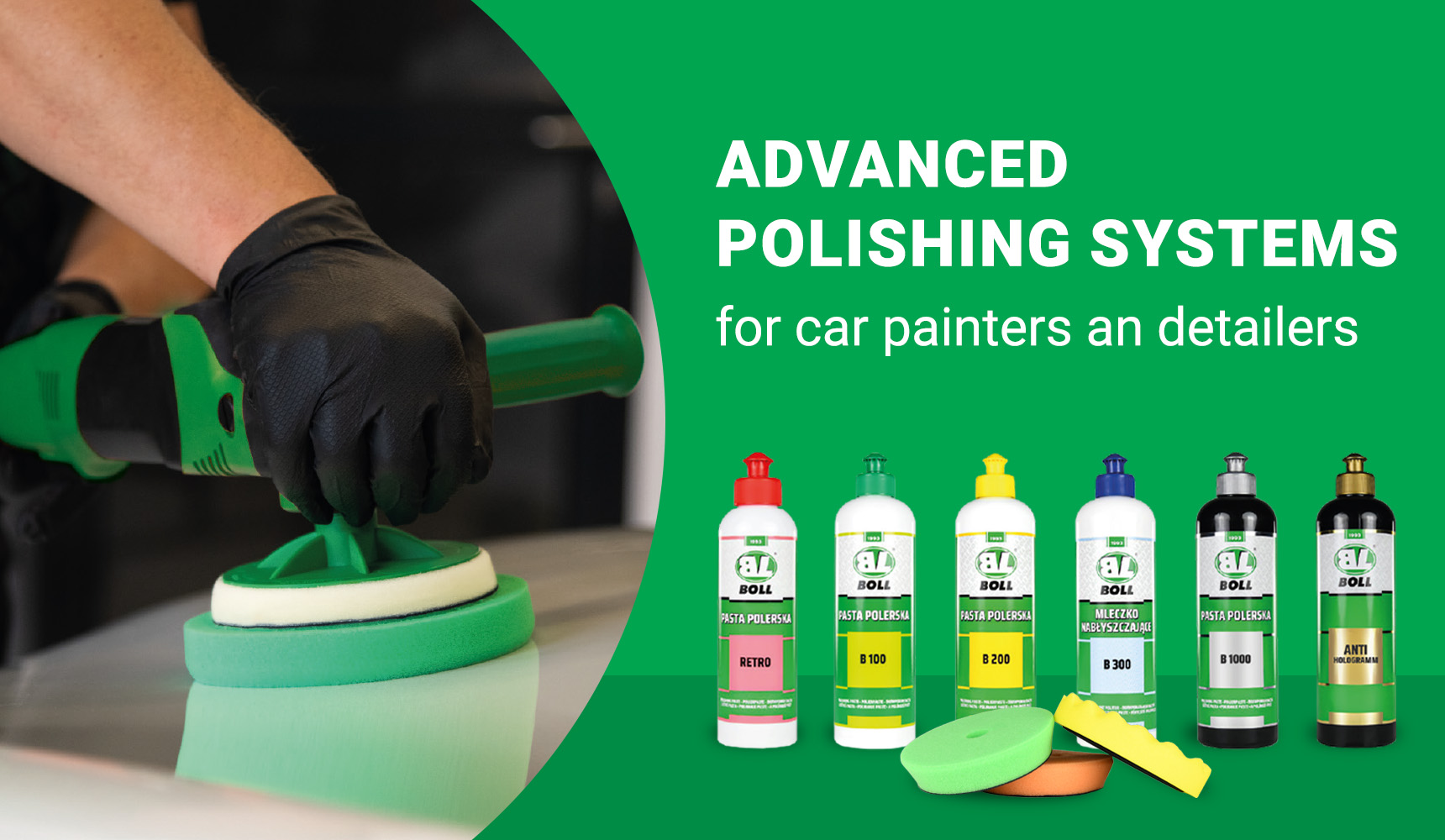
Polishing car paint has two primary goals:
- Improving the look of old paint coatings
Over time, a car's paint loses its shine and becomes dull. There may appear scratches, holograms, and other damages, such as etching caused by bird droppings or insects. In this case, polishing aims to enhance the appearance of the car's body by removing these defects and restoring the desired shine. - Final stage of paintwork
Polishing is also the final stage of paintwork, intended to bring the freshly painted surface to the same appearance as the other elements. Polishing can also, to some extent, correct certain painting errors.
Choosing a Polishing Machine
A mechanical polisher, which is a device with an electric motor that drives a pad attached to it, comes in two types:
- Rotary Polisher: This type only provides rotary motion of the pad. Rotary motion offers greater abrasive capability (more cutting power), which, combined with an aggressive polishing compound, allows for quick correction of more significant damages. The wide range of speed adjustments in a rotary polisher makes it suitable for both finishing and corrective work.
- Dual Action Polisher (orbital): This polisher moves the pad in two ways, providing both rotary and oscillatory (side-to-side) motion. This makes it a safer option for beginners and professionals alike. The oscillatory motion reduces the risk of creating swirl marks and even burning through the paintwork. However, an orbital polisher can be 2-3 times more expensive than a rotary one. DA polishers with a short throw are good for finishing work, while those with a long throw are better for corrective work.
What Types of Polishers Are Used by Painters and Detailers?
Painters typically use rotary polishers, which are significantly cheaper than DA polishers and can be used for both finishing and corrective work (including those requiring the strongest paint cutting). Detailers, on the other hand, use both rotary and Dual Action polishers, which are more expensive but much easier to handle and safer for the paintwork. If you are not a professional and want to perform paint correction yourself, compare the prices of these types of polishers and choose based on your preferences.
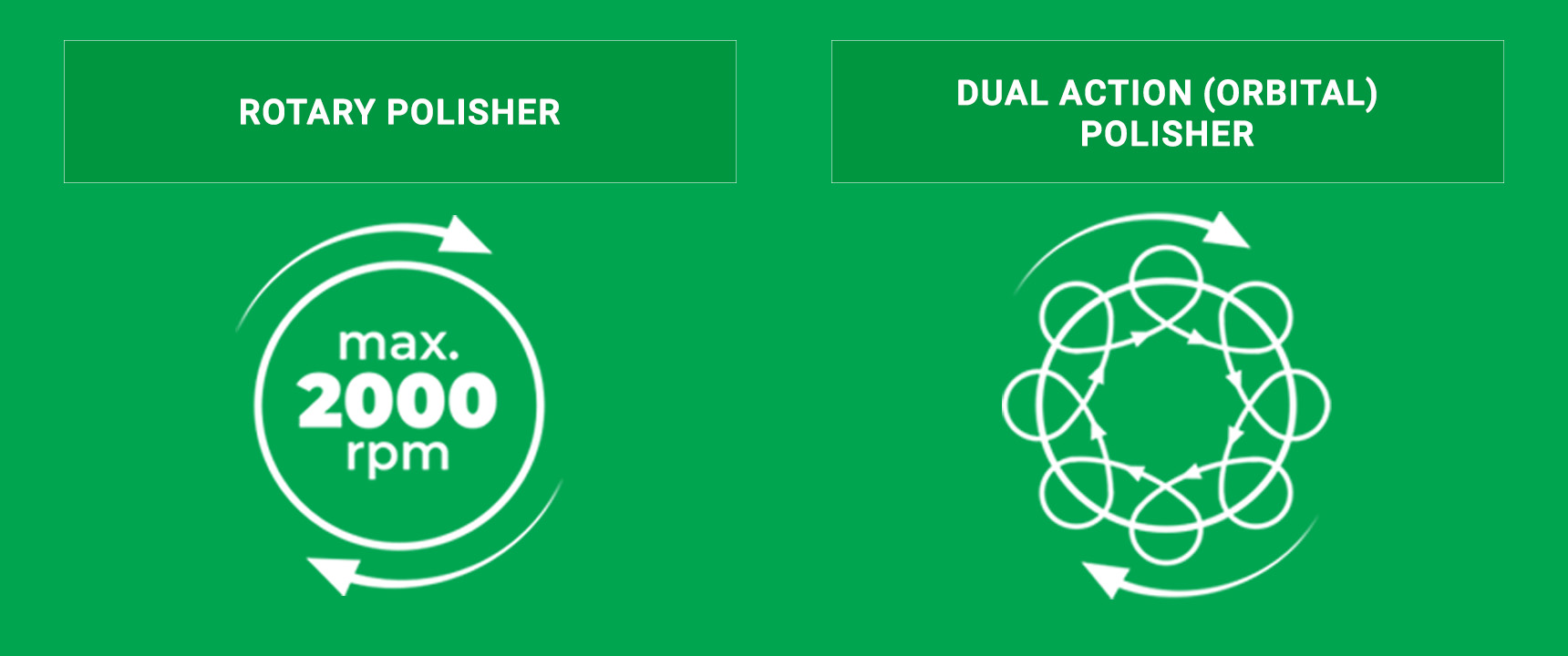
Types of Polishing Pads
A polishing pad is a general term used to describe any type of disk used for polishing, such as sponges. Polishing pads transfer the rotary motion from the polisher to the paint surface and help utilize the abrasive properties of polishing compounds.
The most popular types of polishing pads are:
1. Foam Polishing Pads: Made of closed-cell or open-cell foam, these pads come in various hardness levels, which affect their cutting properties. The harder the foam, the faster it can remove deep scratches. However, improper use of a hard pad can easily damage or even burn through the paint.
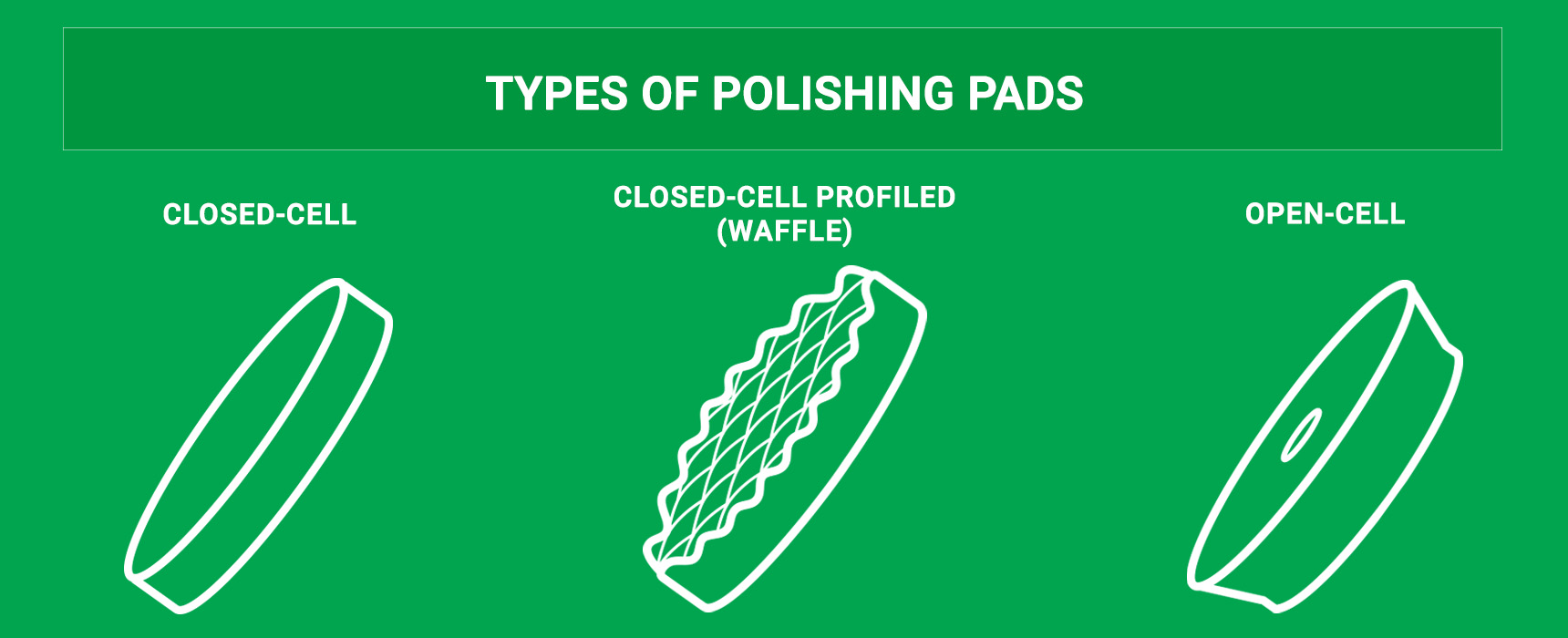
Standard Closed-Cell Foam Pads:
- very durable due to the high number of connections between individual foam bubbles.
- Have lower air permeability than open-cell foam pads, making them suitable for less abrasive compounds (used in the final stage of polishing).
- Recommended only for rotary polishers.
- Available in various hardness levels.
Profiled Standard Foam Pads (Waffle):
- Recommended only for rotary polishers.
- Reduce the risk of creating swirl marks.
- Minimize the splattering of compound during polishing.
Open-Cell DUO Foam Pads:
- Minimize the risk of creating swirl marks on the paint as they generate less heat (thanks to the special foam structure and central hole).
- The special trapezoidal shape of the open-cell foam pad makes it easier to manoeuvre the polisher and allows access to hard-to-reach areas like under door trims or mirrors.
- The bevelled edge of the pad prevents the material form tearing at the edges.
- Easier to keep clean as they do not clog with polishing compound, and the residue can be easily removed with compressed air.
- Recommended for Dual Action polishers but also work well with rotary ones.
- Available in various hardness levels.
The following graphic presents a comparison of BOLL polishing pads categorized by their hardness levels.
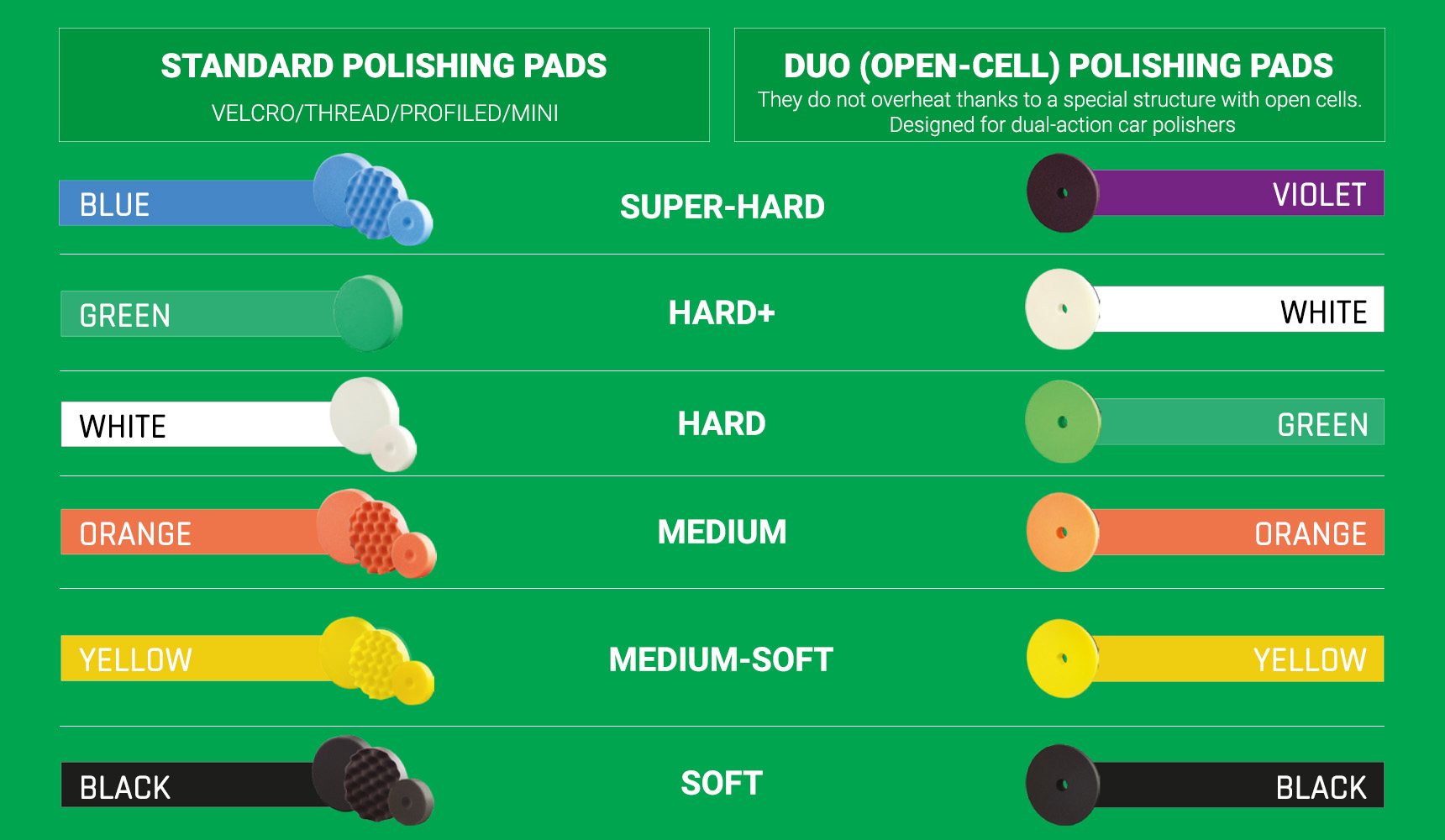
2. Wool Polishing Pads are very aggressive and used for cutting deep scratches and correcting heavily damaged paint. Using a wool polishing pad significantly speeds up work as it removes more material faster than the hardest foam pads. However, it leaves a much rougher finish. Extreme caution is needed when using wool pads, as it's much easier to burn through the paint.
Polishing Compounds
Six polishing products with different properties (varying in cutting and gloss levels) have been selected for various polishing systems recommended by BOLL:
- Polishing paste RETRO – Cutting: 9, Gloss: 5
- Polishing paste B 100– Cutting: 8, Gloss: 6
- Polishing paste B 200 – Cutting: 4, Gloss: 9
- B 300 Sealing wax – Gloss: 10
- Polishing paste B 1000– Cutting: 8, Gloss: 6 (recommended for Dual Action machines)
- ANTI HOLOGRAMM– Cutting: 4, Gloss: 10 (recommended for use after B 1000 and with Dual Action machines)
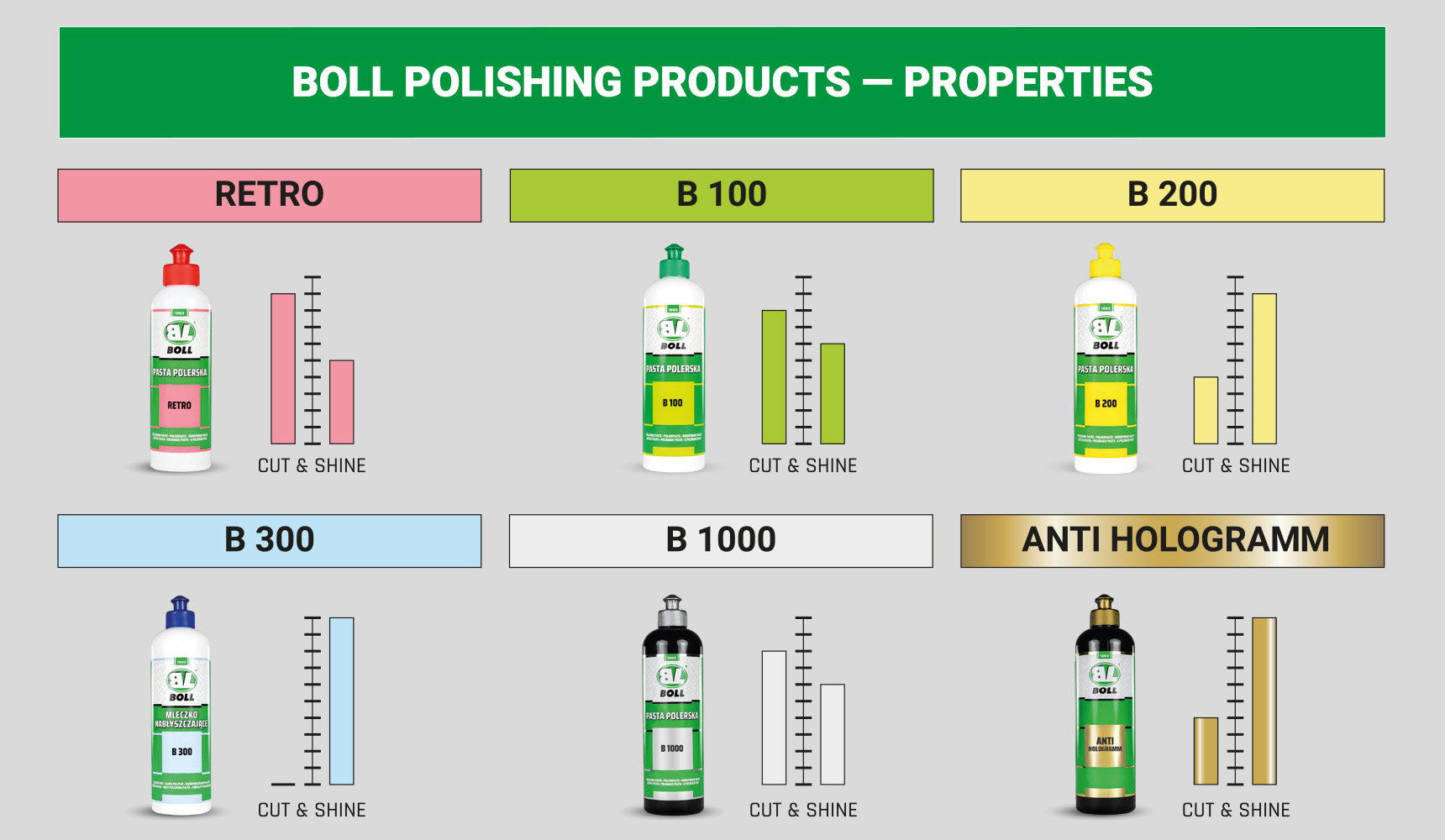
Choose one of five polishing systems described below, created by BOLL experts in cooperation with professional painters and detailers.
REFINISH Systems (1-3) with Rotary Polisher

OPTIMUM System - recommended for complete polishing of heavily hardened paintworks. It involves three mandatory polishing steps and one optional.
- First Step: Remove deeper scratches using polishing paste B 100 with a green standard pad (HARD+) or a green open-cell pad (HARD).
- Second Step: Remove smaller scratches and enhance shine using polishing paste B 200 with a yellow medium-soft pad (standard or open-cell) or a black soft pad (standard or open-cell).
- Third Step: Eliminate swirl marks and achieve deep gloss using B 300 Sealing wax with a yellow medium-soft pad (standard or open-cell) or a black soft pad (standard or open-cell).
- Optional Fourth Step: Provide long-lasting protection against harsh weather conditions and even shinier finish by applying spray wax with a microfiber cloth.

ONE STEP System - suitable for both spot and complete polishing of fresh paintworks. It includes one mandatory polishing step and two optional.
- First Step: Remove deeper scratches using polishing paste B 100 with a green standard pad (HARD+) or a green open-cell pad (HARD).
- Optional Second Step: Eliminate swirl marks and achieve deep gloss using B 300 Sealing wax with a yellow medium-soft pad (standard or open-cell) or a black soft pad (standard or open-cell).
- Optional Third Step: Provide long-lasting protection and a very high gloss by applying spray wax with a microfiber cloth.

ULTRA HARD System - recommended for complete polishing of very old paint coatings, this system includes three mandatory steps and one optional.
- First Step: Remove deep scratches using RETRO Polishing paste with an orange standard pad (MEDIUM) or a yellow open-cell pad (MEDIUM-SOFT).
- Second Step: Remove smaller scratches and enhance shine using Polishing paste B 200 with a yellow medium-soft pad (standard or open-cell) or a black soft pad (standard or open-cell).
- Third Step: Eliminate swirl marks and achieve a deep gloss using B 300 Sealing wax with a yellow medium-soft pad (standard or open-cell) or a black soft pad (standard or open-cell).
- Optional Fourth Step: Provide long-lasting protection and even shinier finish by applying spray wax with a microfiber cloth.
DETAILER Systems (4-5) with DUAL ACTION Polishers

BEST CHOICE System - recommended for complete polishing of old paintworks, it comprises of two mandatory polishing steps and one optional.
- First Step: Remove defects using Polishing paste B 1000 and an open-cell pad selected based on the severity of the scratches – orange (MEDIUM), yellow (MEDIUM-SOFT), or black (SOFT).
- Second Step: Eliminate swirl marks and achieve a deep gloss ANTI HOLOGRAMM and a black soft open-cell pad.
- Optional Third Step: Provide long-lasting protection and even shinier finish by applying spray wax with a microfiber cloth.

ONE STEP System - suitable for both spot and complete polishing of fresh paintworks. It includes one mandatory polishing step and two optional.
- First Step: Remove deeper scratches using polishing paste B 100 with a green standard pad (HARD+) or a green open-cell pad (HARD).
- Optional Second Step: Eliminate swirl marks and achieve deep gloss using B 300 Sealing wax with a yellow medium-soft pad (standard or open-cell) or a black soft pad (standard or open-cell).
- Optional Third Step: Provide long-lasting protection and a very high gloss by applying spray wax with a microfiber cloth.
Basic Polishing Tips:
- Protect the edges of the polished elements with masking tape.
- Remember to impregnate the pad by applying polishing compound to the pad and spreading it on the element by pressing the pad in several spots on the surface.
- Always start polishing with the machine at low speed, increasing the speed only after the polishing paste is evenly distributed over the element.
- Wipe the surface with a soft microfiber cloth and check with an inspection lamp to see if the result is satisfactory.
- Do not polish an area larger than eight times the size of the pad.
- Replace or clean the pads regularly after polishing a maximum of two elements. A clogged polishing pad reduces efficiency, increases dusting and raises the risk of creating swirl marks.